Cotton diseases
Diseases, including nematodes, reduced cotton production in Missouri an estimated 8.7 million pounds in 2001, 19.6 million pounds in 2002, and 39.7 million pounds in 2003. The value of the loss in 2003 was $17.1 million. Clearly cotton diseases are a serious detriment to the cotton farmer's income and the economy of Missouri.
Strategies are available to help cotton farmers minimize the potential yield reduction that diseases can cause. This guide provides information to help farmers and consultants scout cotton for diseases, identify cotton problems caused by diseases, and determine which disease management strategies to use. Cotton yields in fields where pest control decisions were made using the results of pest surveys were conservatively estimated to be 50 pounds of lint per acre greater than where pest control decisions were made without knowledge about the pest populations present in the field.
Table 3
Potentially damaging cotton diseases in Missouri.and their seasonal occurrence
- Seedling diseases
Seed germination to 28 days after emergence - Root-knot nematode
Stunt and galls most evident 6 weeks after planting to harvest - Leaf spot
Seedlings to mature plants - Bacterial blight
Seedlings to mature plants - Wilts
Beginning bloom to first open boll - Bronze wilt
Beginning bloom to first open boll - Boll rots
From first open bolls to harvest
Scouting cotton for diseases
Consultants and farmers should survey cotton for diseases at the same time the crop is surveyed for insects. Symptoms of individual diseases may not be evident throughout the season. The following table shows when disease symptoms are most often observed during the Missouri growing season.
General disease management
There are several strategies for managing diseases in cotton. The three most important are crop rotation, planting disease-resistant varieties, and planting high-quality seed in warm, well-drained soil. An integrated approach that uses all of these methods usually is the most effective and profitable.
Rotating cotton with corn and certain soybean varieties will help manage several cotton diseases. For example, the number of root-knot nematodes in the soil declines when a soybean variety that is resistant to root-knot nematode is planted. The population of this nematode will fall below the cotton damage threshold after planting a resistant soybean variety for a few years.
No variety of cotton is resistant to all cotton diseases. However, some cotton varieties often have improved levels of resistance to root-knot nematode, Fusarium and Verticillium wilt, bacterial blight and bronze wilt. Farmers should choose varieties based on MU yield trials in their area and resistance to locally significant diseases.
Farmers should plant seeds that germinate quickly and produce vigorous seedlings for a uniform stand. There are two germination tests, a warm test and a cool test, that are useful for predicting how a seed lot will perform in the field. In general, the warm germ test (about 86 degrees Fahrenheit) will estimate the percent emergence under highly favorable conditions, while the cool germ test (64 degrees Fahrenheit) will estimate emergence under more typical, somewhat adverse conditions. Minimum acceptable percent germination levels for cotton planting seed are 80 percent on the warm test and 50 percent on the cool test. The warm germination test results are printed on most bags of seed. Growers should ask their seed dealer for the warm and cool germ test results for their seed, and should only plant seed that germinates well, especially when planting early or in heavy soil. Fungicide seed treatments on most commercially sold seed protect seed from rot.
When planting early or in poorly drained, clay soil, use an in-furrow fungicide for extra protection against organisms that cause seedling diseases. The fungicides applied by the seed supplier help protect the seed and seedling against rot (step 2), but will not protect the seedling from all seedling diseases. A fungicide applied in the furrow at planting will provide additional protection against seedling diseases. In-furrow applied fungicides are available in granule or liquid formulation.
Cotton seedling diseases
Several different, normally harmless, microscopic organisms called fungi live on organic matter in the soil and can attack cotton seedling roots in the spring. The fungi most commonly found attacking cotton in Missouri are Pythium, Fusarium, Rhizoctonia and Thielaviopsis. A plant may be attacked by one or several of these at the same time.
The organisms that cause seedling diseases are present in most soils. Once established, they remain there indefinitely because they produce structures that enable them to survive in the soil from year to year.
Seedling diseases become worse when the soil is cool and wet. These conditions do not develop in Missouri every year because of yearly variations in weather, so the severity of cotton seedling diseases also varies from year to year. Seedling diseases cause more yield loss in cotton than any other disease in Missouri.
The microscopic organisms that cause seedling diseases penetrate and grow within the cotton root by secreting chemicals that dissolve the root tissue. The organisms absorb the nutrients they need for growth from the damaged root. The root damage may vary from slight injury (which the root may outgrow), to moderate injury (the plant lives but the root is permanently damaged), to seedling death. Diseased roots are unable to absorb water and nutrients as well as healthy roots, and the plant will grow more slowly. Plants with permanently damaged roots usually shed young bolls more quickly during summer drought, mature later, yield less and produce poorer-quality lint than healthy plants.
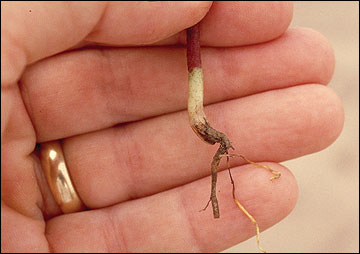
Figure 62
Rotten areas on roots damaged by seedling diseases.
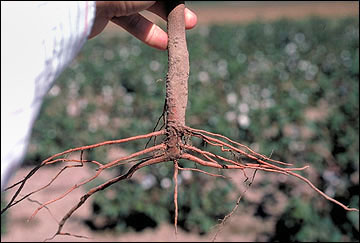
Figure 63
Shallow lateral roots left after the top root has been destroyed by seedling diseases.

Figure 64
Seedling diseases can kill roots, causing seedlings to die.
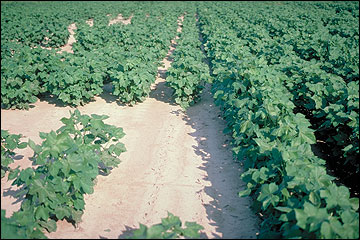
Figure 65
Thin stand due to cotton seedling diseases.
Symptoms
A healthy cotton seedling root is white and firm, and the central root (taproot) is long with numerous secondary white roots. A stand of healthy cotton seedlings is uniform with no skips. Seedling diseases affect young plants in several ways. When damage is mild, dark, rotten areas (lesions) develop on infected roots (Figure 62). When damage is severe, the taproot may be destroyed, leaving only shallow-growing lateral roots to support the plant (Figure 63). When most severe, those diseases kill the root, then seedlings wither and die (Figure 64). Plants that survive infection are often weak, more susceptible to other diseases and environmental stresses, and unproductive. Sometimes seedling diseases will kill entire fields of young cotton, but the most frequent result of these diseases is thin, uneven stands (Figure 65) of weakened plants that grow slowly, yield poorly and have low-grade lint. For a positive diagnosis, send 5 to 10 seedlings with typical symptoms to the MU Plant Diagnostic Clinic. Collect these seedlings by digging them up and gently shaking excess soil off roots. Put these seedlings into zip-lock plastic bags and store them in a cooler until shipment. Send the material by overnight express or deliver it to these individuals.
Management
- Plant only when the soil temperature 4 inches deep has warmed to about 60 degrees Fahrenheitahrenheit by 8:00 a.m. and plant only when five days of warm weather are predicted.
- Plant seeds that germinate quickly and produce vigorous seedlings.
- Plant in fertile soil.
- Plant on raised beds to maximize drainage and the soil temperature of the seedbed.
- When planting early or in poorly drained clay soil, use an in-furrow fungicide for extra protection against organisms that cause seedling diseases.
- Use a device to move trash away from the row when planting no-till, so the sun can more quickly warm the soil around the seed.
Root-knot nematodes
Missouri scientists recently surveyed for cotton parasitic nematodes in Dunklin, New Madrid, and Pemiscot counties, which produce about 98 percent of Missouri's cotton. Reniform nematodes were found in only 3 percent of fields in Pemiscot County and no other county, and root-knot nematodes were present in many fields. Root-knot nematodes were found in 45 percent of fields in Dunklin, 20 percent in New Madrid, and 26 percent in Pemiscot. Fortunately, only a few fields had enough root-knot nematodes to cut yield.
Root-knot nematodes are so named because the galls they produce on roots look like knots in a rope. The most common species of root-knot nematodes are Meloidogyne incognita, Meloidogyne arenaria, Meloidogyne hapla, and Meloidogyne javanica. All four species occur in the U.S. Cotton Belt, but only some populations of the species Meloidogyne incognita (also known as the southern root-knot nematode) attack cotton. This is the only species of root-knot nematode known to be present in Missouri.
Root-knot nematodes will be a greater problem when cotton is planted year after year and when planted in sandy soil. Root-knot nematodes are best adapted to coarse-textured, sandy soils rather than fine-texture silty or clay-based soils.
Southern root-knot nematode populations can be reduced by rotating cotton with a resistant soybean cultivar. The root-knot nematodes that hatch when this soybean variety is grown in a field die due to lack of food. Maintaining a clean, fallow field will also reduce nematode populations. However, this practice is impractical because of the loss of revenue during the fallow period.
Chemical nematicides are widely used to control root-knot nematodes. Numerous studies show that when nematicides are used to control nematodes, yields increase significantly. Yield increases of more than 50 percent are common in severely infested fields. The objective for using chemical nematicides is to protect the seedling roots from nematodes for four to six weeks. By protecting the roots during early development, yield losses will be reduced substantially even though nematodes may penetrate the roots during the latter part of the season. Several nematicides are labeled for use on cotton. All pesticides should be used only in accordance with label instructions.
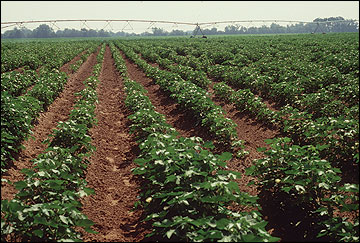 Figure 66
Figure 66
Stunted cotton due to root-knot nematodes.
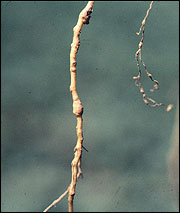 Figure 67
Figure 67
Galls on cotton roots due to root-knot nematodes.
Symptoms
Root-knot nematodes are not uniformly distributed in soil; they occur in irregular patches. These patches may be small and limited in number, or they may be large and widely distributed. Depending on the nematode population, plants in these patches may be damaged and show symptoms ranging from mild to severe stunting (Figure 66). Leaves on infected plants may wilt at midday more readily than healthy plants. In addition, root-knot nematodes cause visible galls or knots on roots (Figure 67). Swellings of the infected root tissues can be found on the cotton taproot and the lateral roots from about six weeks after emergence until harvest. The galls are easier to detect if cotton plants are carefully dug (not pulled) from the soil. For a positive diagnosis, send root and soil samples to a reputable soil and plant testing laboratory. The soil and roots should be kept cool from the time they are collected until shipment. Store the material in a plastic bag in a cooler and ship it by overnight express or deliver it to the laboratory.
Management
- Rotate cotton with resistant soybean varieties.
- Use a nematicide.
Leaf spots
Several diseases attack the leaves of cotton and cause lesions that under favorable conditions can cause considerable damage. The most important of these diseases are Ascochyta blight (wet weather blight), Cercospora leaf spot, and Alternaria leaf spot. These diseases cause various types of leaf spot symptoms.
 Figure 68
Figure 68
Ascochyta blight on cotyledons.
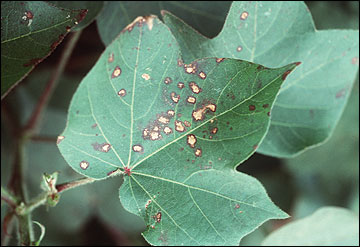 Figure 69
Figure 69
Ascochyta leaf spot symptoms on leaves.
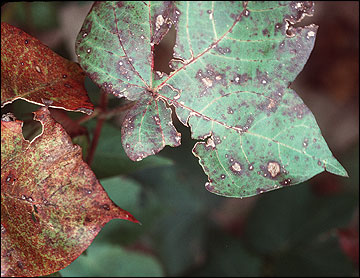 Figure 70
Figure 70
Leasions on leaves damaged by Alternaria leaf spot.
Symptoms
Ascochyta blight is known as "wet-weather blight" because it typically develops on cotyledons and leaves of young plants during wet weather in the spring. A dark brown circular spot (0.1 inch) develops first on cotyledons and leaves (Figure 68). These spots may enlarge over time (Figure 69).
Cercospora leaf spot usually appears on cotton leaves of potassium-deficient plants under stress from drought and on leaves of plants near harvest. The spots, 0.25 to 0.75 inch in diameter, are white to light brown with a narrow red margin. Alternaria leaf spot usually develops on older leaves late in the season in Missouri. The spots are dull brown and circular and may be up to 0.4 inch in diameter. The tissue in older spots may be gray, and this tissue may fall away, leaving holes in the leaf (Figure 70).
For diagnosis, send 5 to 10 leaves with symptoms in a plastic bag by overnight express to a diagnostic laboratory.
Management
- Rotate cotton with corn or soybean plantings.
- Supplying high levels of potassium to the cotton may reduce the incidence and severity of leaf spot diseases.
Bacterial blight
Bacterial blight, sometimes called angular blight, occurs on cotton in most parts of the world. The severity of this disease in the United States was greater in the 1970s than in the 1990s. Weather greatly affects the severity of this disease. Bacterial blight is usually least severe or absent during hot dry conditions, but it can be severe during warm, wet weather. In Missouri, this disease was severe enough in the 1960s and early 1970s to cause yield losses. Missouri farmers experienced little if any yield losses due to bacterial blight in the 1980s, and it was rare in the 1990s. This disease has occurred rarely in Missouri since the mid-1980s because farmers planted acid-delinted seed of varieties with resistance to bacterial blight.
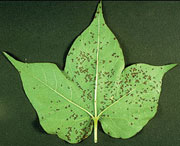 Figure 71
Figure 71
Lesions on leaves damaged by bacterial blight.
Symptoms
On cotyledons, bacterial blight causes small, quarter-inch-diameter lesions that are initially dark green turning to dark brown. It may cause black cankers on the stems of seedlings and older plants. Symptoms on the leaves may appear throughout the growing season. Symptoms will be most severe on leaves when the humidity is high with air temperatures average 86 to 95 degrees Fahrenheit and when rain, heavy dew, fog or sprinkle irrigation are frequent. The first leaf symptoms are light-green spots that are visible on the upper and lower surfaces of the leaves. These spots are usually 1/16 inch to 1/8 inch in diameter and quickly turn dark brown to black (Figure 71). The margin of these spots will have some sharp angles. Leaves with lots of individual lesions may defoliate prematurely. This disease may also develop on bolls. The round, light-green lesions on bolls may develop into boll rot.
Management
- Rotating cotton with soybean or corn plantings for one or more years will help reduce the severity of bacterial blight on the next cotton crop.
- Plant only acid-delinted seed produced in fields free of this disease.
- Plant resistant varieties.
Wilts
There are two major wilt diseases of cotton in Missouri, Fusarium wilt and Verticillium wilt. Both are caused by microorganisms that live in the soil on organic matter but can attack cotton roots.
Verticillium wilt was first recorded as a cotton disease in the United States in the early 1900s. The microorganism that causes this disease can survive in soil for many years without cotton. The severity of this disease is greater during cool, wet growing seasons, and in Missouri it is a greater problem than Fusarium wilt.
Fusarium wilt was first described in the United States in 1892. This disease has developed in most cotton-growing areas of the world.
Positive diagnosis of wilt diseases in the field is difficult because the symptoms of each are similar. For a positive diagnosis send the lower stems of 5 to 10 plants to a diagnostic laboratory.
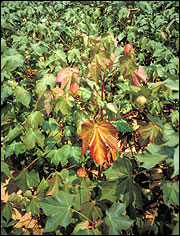 Figure 72
Figure 72
Leaf yellowing and dying due to Verticillium and Fusariuim wilt.
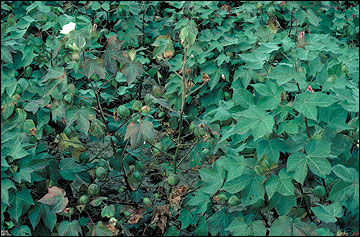 Figure 73
Figure 73
Premature defoliation due to Vertcillium and Fusarium wilt.
Symptoms of Verticillium wilt
Although Verticillium wilt can attack seedlings, symptoms of this disease are most often observed in Missouri on plants from first flower to harvest. There is a progressive yellowing and dying of the leaf tissue between the major veins of the leaves (Figure 72), beginning on the lower leaves and then progressing to the younger leaves. These symptoms are similar for Verticillium and Fusariium wilt.
Affected plants may shed both leaves and bolls prematurely (Figure 73), and the inside of the lower stem will be streaked with brown (Figure 71). This discoloration is usually evenly distributed throughout the stalk. Most plants will survive throughout the growing season and will put on new growth at the base of the plant.
Management of Verticillium wilt
- Plant tolerant varieties.
- Do not use excessive nitrogen.
- Rotate cotton with corn and grasses (wheat, oats, etc.).
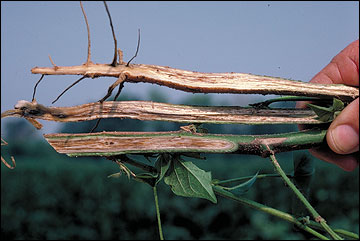 Figure 74
Figure 74
Brown streaks visible inside cotton stems are a symptom of Fusarium wilt.
Symptoms of Fusarium wilt
Fusarium wilt symptoms can appear at any stage of plant development and will vary with environmental conditions. Generally, the first symptoms appear on leaves about the time of first flowering.
Symptoms appear first at the margin of the leaf, where small areas turn yellow and then brown (Figure 72), and the leaf then wilts. Although wilting is usually gradual, sudden wilting may occur shortly after a midsummer rain that follows a dry period. Tissue inside the lower stem of infected plants will be discolored (Figure 74).
Although Fusarium wilt can occur in the absence of root-knot nematodes, nematode feeding increases the susceptibility of plants to this disease.
When both the Fusarium wilt fungus and nematodes are present, there is a significant increase in the damage to plants.
Management of Fusarium wilt
- Tolerant varieties should be planted.
Bronze wilt
During the late summer of 1995, cotton plants in several southeast Missouri fields began to discolor. The leaves turned from green to bronze, and the leaves wilted at midday. This malady was referred to as bronze wilt. These symptoms also developed on some plants in some fields in Arkansas, Louisiana, Texas and Tennessee. This malady did not develop in Missouri in 1996 and 1997. It affected many plants in several fields in 1998, and yields were reduced in some fields. Symptoms of bronze wilt also developed on a few plants in some Missouri cotton fields in 2000.
 Figure 75
Figure 75
Red coloration is a sign of bronze wilt damage.
Symptoms
The first visible symptom of bronze wilt is the red and bronze discoloration of leaves (Figure 75). The discolored leaves will feel warmer to the touch than leaves of normal plants. The stems and petioles of affected plants turn red soon after the leaf color changes. The leaves of affected plants will droop during the hottest part of the day and may recover partially or completely by early morning. These plants may occur next to plants that appear normal. Affected plants will grow more slowly than normal plants and may become difficult to see in a few weeks because of overshadowing by nearby normal plants. The leaf discoloration may disappear soon after a rain or irrigation but will develop again as the soil dries. All squares and small bolls will shed from affected plants within a week of when symptoms begin to develop. However, squares that develop on these plants after soil moisture becomes abundant may remain attached and mature bolls may develop.
Management
- Plant varieties that have exhibited few if any symptoms.
Boll rots
Boll rots cause losses in all cotton-growing regions of the world, but the extent of the loss varies widely with climate. Damage is generally much greater during wet growing seasons. Abundant rain and high humidity during late summer and fall are optimum conditions for boll rot. Some attack the boll themselves, and others enter the boll through wounds on the boll such as those made by insect feeding.
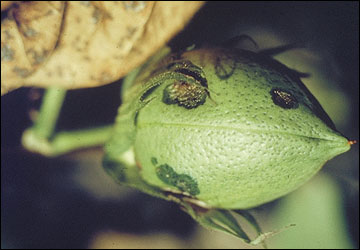 Figure 76
Figure 76
Dark, withered bolls damaged by boll rots.
Symptoms
Initial symptoms are small brown or reddish brown spots on the outside of boll capsules or bracts. If moisture is abundant, these spots enlarge (Figure 76) and may encompass the entire boll. In the later stages of the disease, the bolls turn brown or black. Then the boll dries rapidly and usually splits open, exposing the blackened cotton.
Management
- Avoid excessive application of nitrogen fertilizer, which promotes rank growth.
- Control insects.
- Treat plants with growth regulators if rank growth is anticipated.
Summary of general cotton disease control measures
- Plant high-quality seed.
- Plant on a high bed and enhance drainage of field.
- Plant when the soil temperature 4 inches deep at 8:00 a.m. is 60 degrees Fahrenheit and when five days of warm weather are predicted.
- Plant only in fertile soil.
- Use an infurrow fungicide when planting cotton early in the season (mid-April in Missouri), in clay soils and in poorly drained fields.
- Rotate cotton with wheat, soybean or corn crops.
- Plant varieties that have high yield potential and resistance to diseases.